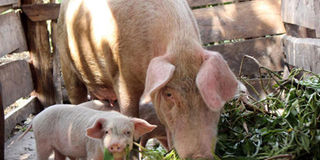Fighting Swine Fever: Avoid these blunders

Pigs contribute significantly to food security due to their high birth rate, but African Swine Fever (ASF) remains the biggest threat to the animals. NMG PHOTO
What you need to know:
- The disease can be confused with classic swine fever (CSF), another viral disease of pigs or some bacterial infection.
- However, the mortality of CSF might not be so high while the bacterial diseases respond to antibiotic treatment.
The world’s pig population stands slightly at over 770 million, with China contributing about 400 million to that figure.
The East African countries are not left behind with a 2012 report indicating that Kenya had 354,600; Burundi 377,038; Rwanda 989,316; Tanzania 500,000 and Uganda 2.4 million.
Pigs contribute significantly to food security due to their high birth rate. However, African Swine Fever (ASF) remains the biggest threat to the animals.
The disease is endemic in East Africa having been confirmed in Kenya last September. The outbreak of the disease is aggravated by the fact that there is no commercial vaccine for it.
The good news is that with strict livestock husbandry, a farmer can keep the disease at bay. Key management practices include rearing pigs in confinement; not feeding them swill and if the food waste has to be used, it must be heated.
ASF affects pigs of all ages with morbidity (infection) and mortality (death rate) approaching 100 per cent in a given unit.
The disease affects both domestic and wild pigs and transmission is through direct contact, through the
soft tick vector that affects the animals and indirect contact by vehicles and human feet, clothes and equipment from infected premises.
The virus is resistant to a wide range of pH and freeze/thaw temperatures and can remain infectious for many months at room temperature or when stored at 4oC. It can also remain in processed meat for several weeks. However, the virus in body fluids is inactivated in 30 minutes at 60oC. The virus is restricted to pigs and does not affect humans. The clinical signs appear 5-15 days after the virus introduction and they include sudden death and or high fever (up to 42oC), purplish discolouration of the abdomen and extremities of legs and ears.
In chronic cases, the animals might be found lying on their sides paddling and with laboured breathing and vomiting is not unusual. Diagnosis is through serum and organ samples taken during post-mortem examination.
Human transmitters
The other human transmitters of ASF are pig traders who buy animals from all over the country and deliver to the slaughterhouse or distribute to other farmers. These people should never be allowed into the pig sheds unless they change clothing and disinfect themselves before entering the pig houses.
ASF control measures
Rearing pigs in confinement/stalls/pens is a key control measure because of the direct contact transmission nature of the disease. Introduction of new animals serves the same purpose especially if they are from markets or free-range farming systems.
It is, therefore, recommended that a farmer quarantines incoming pigs for at least two weeks before mixing them with the resident animals.
Bio-security measures such as wheel and footbaths as well as disinfection of incoming equipment is also important.
Farm input supply systems like common feed and water supply vehicles are known to transmit the disease, thus, collect the supplies from source.
Observing strict livestock movement control by seeking a movement permit and the “no objection” from the nearest veterinary office is one way of tracking the disease as the government is always informed on disease spread and is thus a good source of information.
Second on the list of ASF predisposing factors is feeding of pigs with swill (kitchen food waste mixed with water) especially those contaminated by the virus from partially treated pig meat. Others in this category include slaughter house waste such as blood. Swill and blood should be heated to 60oC for 30 minutes while meat should be at 70oC for the same period.
Farmers and animal health service providers should acquaint themselves with the disease’s clinical manifestation and should report and also submit relevant samples for confirmation of the same.
The government, on its part, should enhance search for the vaccine; impose quarantines when there is an outbreak; regulate and monitor illegal animal movement; intensify local and trans boundary disease surveillance; issue early warnings where there is a potential threat and explore ways of compensating farmers who kill and dispose of affected and in-contact animals.




